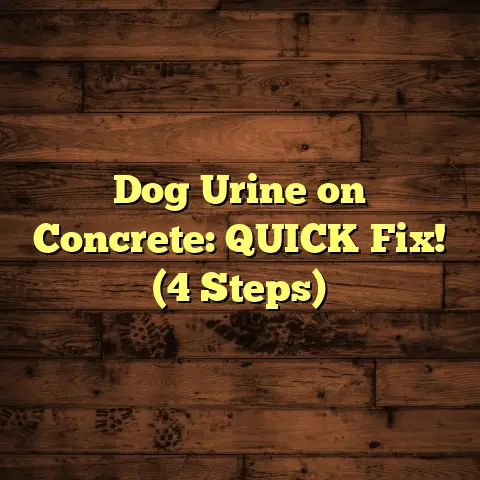How Long for Epoxy Floor to Dry? (24 Hr Cure?)
I get it. You’re staring at this shiny new surface, itching to get back to work, park your car, or just, you know, walk on it! Let’s dive deep into this, because “dry” and “cured” are two different beasts.
Think about it like this: you’re standing in a massive warehouse, the air thick with the smell of fresh epoxy. The floor gleams, promising years of heavy-duty service. But that promise hinges on one thing: patience.
How long really will it take? Let’s find out!
Section 1: Understanding Epoxy Flooring
1.1 What is Epoxy Flooring?
Okay, so what is this stuff, anyway? Epoxy flooring isn’t just paint. It’s a thermosetting polymer, which basically means it’s a mixture of resin and hardener that, when combined, creates a chemical reaction resulting in a rigid, durable plastic.
Think of it as liquid plastic that hardens into a super-tough surface.
Common applications? Garages, warehouses, factories, hospitals, even fancy showrooms. Why? Because epoxy floors are resistant to chemicals, abrasion, and impact. Plus, they look pretty darn slick!
The installation process usually involves prepping the concrete substrate, mixing the epoxy components, applying the epoxy, and then… waiting. And that’s what we’re here to talk about!
1.2 The Science Behind Epoxy Curing
Here’s where things get a little nerdy, but stick with me. The “curing” process is the chemical reaction between the resin and hardener. This isn’t just drying; it’s a transformation at the molecular level.
Think of it like baking a cake. You mix ingredients, apply heat, and voila! A cake emerges. Epoxy is similar, but the heat comes from the chemical reaction itself (exothermic reaction).
Drying vs. Curing: Drying is simply the evaporation of a solvent. Curing is the actual hardening and strengthening of the material. Epoxy doesn’t really “dry” in the traditional sense; it cures.
Temperature and humidity play a huge role. Too cold, and the reaction slows down to a crawl. Too humid, and you might get surface imperfections. We’ll get into that more later.
Section 2: Factors Affecting Drying Time
Alright, let’s get practical. So many things can mess with your epoxy’s drying time.
2.1 Temperature and Humidity
This is huge, folks. Epoxy loves a Goldilocks zone: not too hot, not too cold. Ideally, you want to be somewhere between 65°F and 85°F (18°C and 29°C) with humidity below 75%.
Why? Because temperature affects the speed of the chemical reaction. Colder temperatures slow it down, sometimes dramatically.
Humidity can cause blushing (a cloudy or greasy film) on the surface of the epoxy.
Seasonal considerations? Installing epoxy in the dead of winter or during a sweltering summer heatwave? You’re asking for trouble.
I’ve seen jobs where guys tried to rush it in the winter, and the epoxy took days longer to cure. Not fun.
2.2 Thickness of the Coating
Duh, right? The thicker the epoxy, the longer it takes to cure. It’s like trying to bake a giant cookie versus a thin one.
Optimal layer thickness? Generally, around 8-12 mils (thousandths of an inch) is a good starting point for a durable floor. But, if you’re using a self-leveling epoxy, it could be much thicker.
I remember one project where the client wanted a super-thick, high-gloss finish. We ended up applying multiple thin coats instead of one thick one to ensure proper curing and avoid bubbles.
Case study: A thin coat (4 mils) might be ready for light foot traffic in 24 hours, while a thick coat (20 mils) could take 72 hours or more.
2.3 Type of Epoxy Used
Not all epoxies are created equal! You’ve got different formulations, each with its own curing characteristics.
100% solids epoxy: This is the good stuff. It contains no solvents, so it doesn’t shrink as it cures. It’s generally more durable and chemical resistant, but it can be more expensive and has a shorter pot life (the amount of time you have to work with it after mixing).
Water-based epoxy: Easier to apply and clean up, but not as durable as 100% solids. Dries faster, but may require more coats.
Solvent-based epoxy: Becoming less common due to environmental regulations. Contains solvents that evaporate during curing, leading to shrinkage.
Comparative drying times? A 100% solids epoxy might take 24-72 hours to be ready for light foot traffic, while a water-based epoxy might be ready in 12-24 hours.
Choosing the right epoxy depends on your specific needs and budget.
2.4 Substrate Conditions
Your concrete floor needs to be clean, dry, and properly prepared.
Why? Because epoxy doesn’t like to stick to dirty, oily, or damp surfaces. Moisture in the concrete can cause the epoxy to bubble, peel, or not cure properly.
Pre-installation checks? Moisture testing is crucial. You can use a calcium chloride test or an electronic moisture meter to check the moisture content of the concrete.
I once skipped the moisture test (rookie mistake, I know!) and ended up with a floor that looked like the surface of the moon – full of craters. Lesson learned!
Necessary preparations include grinding or shot blasting the concrete to create a profile that the epoxy can grip onto.
Section 3: General Drying and Curing Times
Okay, let’s get down to brass tacks. How long are you really going to be waiting?
3.1 Standard Drying Times
Keep in mind that these are general guidelines. Always refer to the manufacturer’s instructions for the specific epoxy you’re using.
Typical drying times:
- Light foot traffic: 24-72 hours
- Heavy foot traffic: 72 hours – 7 days
- Vehicle traffic: 7 days or more
After 24 hours? It might be dry to the touch, but it’s probably not fully cured. Walking on it too soon could leave footprints or damage the surface.
Factors that might extend these times? Low temperatures, high humidity, thick coatings, and improper mixing are all culprits.
3.2 Full Curing Timeline
This is where the magic happens. Full curing is when the epoxy achieves its maximum hardness, chemical resistance, and durability.
How long until maximum durability? Usually, 7 days is the magic number. But again, check the manufacturer’s specs.
Signs that the epoxy has fully cured? It should be hard, smooth, and resistant to scratching. You shouldn’t be able to dent it with your fingernail.
I always tell my clients to be patient. Rushing the curing process is like pulling a cake out of the oven before it’s done – you’ll end up with a gooey mess.
Section 4: Practical Implications and Recommendations
Let’s talk about how this all affects your project.
4.1 Planning for Installation
Timing is everything. You need to factor in drying and curing times when scheduling your epoxy floor installation.
Recommendations for businesses? Plan the installation during off-peak hours or weekends to minimize disruption.
Recommendations for homeowners? Choose a time of year with favorable weather conditions.
Importance of patience? I can’t stress this enough. Rushing the process will only lead to problems down the road.
4.2 Testing for Dryness
Don’t just assume it’s dry. Do some tests!
Methods to test if the epoxy is dry to the touch? Gently touch the surface with your finger. If it’s tacky or leaves a fingerprint, it’s not ready.
Visual and tactile cues of readiness? The surface should be smooth, hard, and glossy. There shouldn’t be any soft spots or sticky areas.
When to consult professionals? If you’re unsure, it’s always best to call in the experts. We have the tools and experience to accurately assess the curing progress.
4.3 Post-Installation Care
Congrats, your floor is installed! Now, let’s keep it looking great!
Best practices for maintaining your epoxy floor? Regular cleaning with a mild detergent and water. Avoid harsh chemicals or abrasive cleaners.
Common mistakes to avoid? Dragging heavy objects across the floor, dropping sharp objects, and using acidic cleaners.
Recommended cleaning and maintenance routines? Sweep or vacuum regularly to remove dirt and debris. Mop with a neutral pH cleaner as needed.
Section 5: Troubleshooting Drying Issues
Uh oh, something’s gone wrong. Don’t panic!
5.1 Common Problems Encountered
Bubbling: Caused by moisture in the concrete, improper mixing, or applying the epoxy too thickly.
Peeling: Caused by poor surface preparation, moisture, or incompatible epoxy.
Discoloration: Caused by UV exposure, chemical spills, or improper mixing.
Possible causes tied to drying times and environmental factors? Slow curing due to low temperatures can exacerbate these issues.
How to address these issues? Small bubbles can sometimes be popped with a heat gun. Peeling requires repairing the affected area and reapplying the epoxy. Discoloration may require a new topcoat.
5.2 When to Seek Professional Help
Let’s be real, sometimes you’re in over your head.
Signs that the installation has gone awry? Extensive bubbling, widespread peeling, or uneven curing are all red flags.
The role of professional contractors? We have the knowledge, experience, and equipment to diagnose and fix these problems.
Understanding warranties and guarantees? Make sure you understand the terms of your warranty before you start the installation.
I’ve seen DIY projects turn into complete disasters because people tried to save a few bucks. Sometimes it’s worth paying for professional help to get the job done right.
Conclusion: Reflections on Epoxy Flooring
So, back to that warehouse. You’ve waited, you’ve tested, and now you’re finally ready to step onto your new epoxy floor.
You realize that understanding the drying and curing process wasn’t just about patience, it was about ensuring the longevity and performance of your floor.
By understanding the factors that affect drying time, troubleshooting common problems, and following proper installation and maintenance procedures, you can ensure that your epoxy floor will look great and perform well for years to come.
And that, my friend, is what it’s all about! Now go enjoy your awesome floor!





